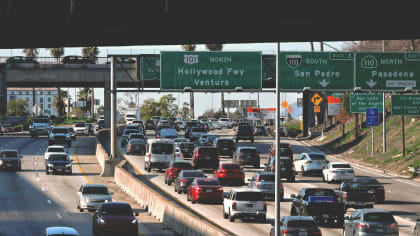SAVING THE BEST FOR LAST
Pirelli World Challenge
This article is from our archives and has not been updated and integrated with our "new" site yet... Even so, it's still awesome - so keep reading!
Published on Wed, Apr 24, 2013
By: The LACar Editorial Staff

Story by Brian Kennedy
Pictures by John Grafman
It’s hard to know how to rate the last race of the weekend at Long Beach every year. For some, it’s an excuse to sit for an hour more, listen to a final roar along the shore, and allow the traffic leaving the city to thin. For others, the hardcore racing fans, it’s one more chance to watch good competition.
Sunday, it was that and more. The most surprising thing in the world happened at the end of what’s known as the Pirelli World Challenge race when the leader blew up, under caution, to pass the victory on to someone else. In fact, that winner, James Sofronas, was third with a few laps to go, and would have done well to get that spot. But the leader at the time, Andy Figge, had a brake failure and, all on his own, pitched himself into the wall.
Behind him, a probably gleeful Johnny O’Connell assumed the lead, but he also inherited trouble. There was debris all over the track, and some of it punctured his radiator. He spewed out water for a lap, then, under caution, blew sky high, smoke trailing out of the pipes. That gave the lead, and the win, to Sofronas. So for every time you’ve heard a TV commentator trying to build interest in a yellow-flag finish by saying, “They’ve still gotta get around to the checkered flag,” here was your payoff. As Andy Pilgrim, who took 2nd overall and in GT, said, “It was a strange race. Just a strange race.” Mike Skeen was 3rd overall and in GT class in a Corvette.
“I was thinking I’ve got second, but then all of a sudden he goes boom, and I pulled over and just looked at him, asking ‘Did that just happen’?” That was Sofronas’s summation.

Th was getting much better runs out of the hairpins than me with that front-wheel drive. I got to be a little bit cautious in power down areas. Fortunately, the lap before [the pass] I got a good enough run, but I didn’t get close enough. The second lap, I could get close enough to get up under him to make the pass. I was a little tentative that first try. I probably should have gotten it, but I knew we had some time left. I had to get close enough to dive-bomb him.”
The pass was daring, to the inside up over a bit of curbing, and exciting to watch. “In all honesty, it was the only spot on the track to do it. We were always good under braking, but we also seemed to lose it down straightaways. . . .”
Aschenbach was working on little sleep. He had been back and forth across the country twice this weekend, racing and testing in Atlanta also. Earlier in the race, he had made another good pass, on a restart, to overtake fellow Camaro driver Andy Lee.
Second in GTS stood Peter Cunningham in an Acura, and third was Jack Baldwin, who tells the story of his car below.
Of course, the kind of action fans saw in the LBC Sunday might happen in any racing series, but what’s significant about it occurring in the PWC is that this is the series that others in the country aspire to be. Or maybe better, it’s the fulfillment of a set of desires that race fans often articulate but haven’t figured out has an answer.
Hence, perhaps, the relatively low placement on the LBGP ladder, last, and the rather sparse attendance that resulted. What a pity.
This series is the honest-to-goodness stock car racing that everyone’s lamenting has disappeared elsewhere. The cars are largely what you could buy in a showroom, and in fact, that’s where many have come from. And unlike the ALMS, which also ran at Long Beach, they are all street cars. ALMS, fast and wonderful as it is, has what are known as “prototypes,” which are open-cockpit, closed-wheel single-seaters that always make me want to ask, “Prototype of what”?
The Pirelli World Challenge, by contrast, runs stuff that I recognize, in the same configuration as I could buy it. It’s the perfect antidote to the question that perhaps more people ought to ask.

The series runs two classes of cars on track together, GT and GTS. The differences are mainly in horsepower, but the GT cars are also allowed more extensive body mods than the GTS cars are. Even still, GT cars, which in the heavier models like the Nissan GTR are mostly made of carbon fiber, look just like their street counterparts, with the exception of some flaring of fenders. They are not the grotesque caricatures of their production counterparts that NASCARs are, for instance. They still retain the shape of the original car, and the aero mods do not extend their lower valences downwards to the point that the cars lose their distinctiveness.
Just compare a NASCAR Camaro (in the second tier of their series) to a PWC Camaro (GTS class), and it’s immediately evident what this means. The latter still has all the body lines, the distinctive slit rear window, the flat trunk. It’s a Camaro, in other words.
The GTS cars are quite close to the real thing. In fact, the guy who got third in that class at Long Beach, Jack Baldwin, got his car from a New Jersey dealer as a Porsche Certified Used Car, and he said it no sooner than got in the door but they were stripping stuff out of it. Still, the body work is original, the interior is upgraded only for safety and to lighten it (roll cage, racing seat, no accessories like carpet or HVAC controls). The team car to his, Buz McCall’s Cayman S, came from a Chicago-area dealer as a new car. Both were bought with car loans just like you and I might get, because that’s the cheaper way to do it, according to Baldwin. “It’s not like buying a race car; you’re buying a car,” he said.
The other great thing about this series is that it’s not just restricted to cars the rich and famous might own. There are Kias, Camaros, Mustangs—rides that you could have for anywhere from $20-55 thousand bucks (the Mustang is a Boss 302).
The mechanical-technical variety is also fun. There’s AWD (Volvo, Audi), FWD (Kia, Acura, etc.) and RWD (Mustang, Camaro, etc.), and bodystyles include both coupe and sedan. Those Volvo S60s, if you didn’t realize it, are four-door models.
Look up some NASCAR history, and you’ll find that they’ve even run convertibles back in the day, and that once upon a time, all sorts of makes contested their races. Further, they were grassroots teams back then.

Nobody’s saying that PWC is grassroots, as a “cheap” entry, say the Cayman S bought used and driven by Baldwin, might be up to $200 grand all outfitted and with a small crew to run it. But it’s racing where the driver can still wrench, and probably needs to to keep costs down. On the higher end is the Nissan GTR of Tim Bell, who placed 11th on Sunday. His team manager, Nicholas Short, told me that his car might be worth about $400 thousand developed as it is for GT racing. “Bring your helmet, we’ll put you in it,” he said.
“It’s mainly a stock engine,” Short said. “The bigger cars, the Cadillac and Volvo, to keep them stock and turn them into race cars is a little difficult. That’s why the Cadillac engine is set back four inches and down four inches. So is the Volvo’s.”
Technically, under the hood, the cars have some mods. All are allowed aluminum radiators and modified intakes, and GT cars can change engine placement for better balance. Each class also allows what one mechanic told me are “unlimited brakes.”
The sponsor of McCall and Baldwin’s car, speaking of which, is Stop Tech, a local SoCal company which has three locations and employs hundreds of people.
For those who do like the technical aspects of racing, there’s still plenty on offer in this series. Dax Raub, Design Engineer for the Volvo team, described to me some of the specs of his car. “The street car is more electronically controlled, and that would be too much benefit for us in the racing deal, and it’s also, the street car is designed around street, snow, slick kind of performance. Here, we’re designed around the grip. Kind of a different reason to have all-wheel drive.” He further said that the relationship between this car and the street one is that the sheetmetal chassis of a street car is maintained, and then all the body work is replaced with carbon fiber. “It fully mimics the street car. [The exception is] in the center, it’s stock, but it starts flaring out toward the rear just to cover the tires.”
Under the hood, it’s got stock crank, cams, and bore, but the turbo is used to get power in it. They also put new cylinder wall liners in, “to handle the boost and the abuse that we do, but it’s still the same bore. It’s only for reliability that we do that. We up the boost to get the power. The class is a 500-550 hp range.” The car weighs 3350 pounds. “AWD is a lot of weight, but the heavier you are the more horsepower you get, to make it a level playing field.”
The Volvo team gets an advantage on the standing start the series uses, Raub said, but he added that “We’ve got a gentleman’s agreement not to perfect the standing start to any more advantage than [AWD] naturally gives us,” by which he means traction control. “It already does a zero second 0-60, where the other cars are 3.3 seconds.”
The team would have won, as noted above, except for a brake failure. Raub explained that the drivers of an AWD car experience more push than they might be used to in a rear-wheel drive car, since when wheels are driving the car, they don’t turn it as well. He said that “they have to be patient, and deal with the push, and a little slower in the middle of the corner. They get used to that patience, and then we exaggerate that difference in the way the car gets out of the corner,” which is where their advantage is.
Go around the paddock of a World Challenge race, and you could hear a similar story, yet with a different set of details, from each of the teams. This is what racing is. This is intrigue. It’s too bad more haven’t yet caught on.

As GTS class winner Aschenbach told me before he got in his car, “I’m a full-bore sports car driver. I didn’t make it in open-wheel since I didn’t have the sponsor money, but I won a championship in World Challenge GT in 2006 and got picked up, and the rest is history since then. I’ve got no interest in NASCAR, unless it was a deal that made sense for me. The future is sports car racing, in America. People can relate to the cars, manufacturers can relate to the cars. It makes a lot of sense for everybody involved.” That’s what I’m saying. Next race for this series is May 17-19 at the F1 track in Texas. But in the meantime, you can watch the race at Long Beach for yourself online at http://www.world-challengetv.com/#/races/618 or look for a TV replay on the NBC Sports Network on May 5th. Follow me on Twitter @growinguphockey, please. Follow LA Car on Twitter @lacarcom. To read LA Car's report on the Toyota Grand Prix of Long Beach Indycar IZOD race, go to A Day of Firsts To read LA Car's report on the Indy Lights in Long Beach, go to Saving the Best for Last [nggallery id=gplb2013pwc]




